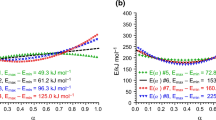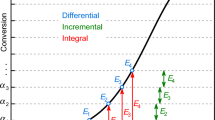Abstract
Thermoanalytical curves of two parallel competitive reaction systems and of two systems in which two mutually independent reactions occur concurrently are made by simulation, as well as isothermal curves of the systems. From these curves, an effect of heating rate is illustratively shown; one peak is observed in a derivative thermoanalytical curve at one heating rate, while a shoulder or two peaks appear in another derivative curve of the same reaction system at another heating rate. An advantage of thermal analysis over isothermal experiments, and its limitations, are discussed.
Résumé
On a simulé les courbes d'analyse thermique de deux systèmes parallèles de réactions compétitives et de deux systèmes dans lesquels deux réactions mutuellement indépendantes ont lieu de manière concurrente. On a établi de même les courbes de ces systèmes en chauffage isotherme. L'effet de la vitesse de chauffage a ainsi été mis en évidence. On observe un pic sur la courbe d'analyse thermique dérivée pour une certaine vitesse de chauffage tandis qu'avec le même système, mais pour une autre vitesse de chauffage, on obtient un épaulement ou deux pics. On discute les avantages de l'analyse thermique sur l'étude isotherme ainsi que ses limites.
Zusammenfassung
Die thermoanalytischen Kurven zweier paralleler kompetitiver Reaktionssysteme und zweier Systeme, in welchen zwei voneinander unabhängige Reaktionen gleichzeitig stattfinden, wurden simuliert, sowie die isothermen Kurven der Systeme ermittelt. Diese Kurven veranschaulichen die Wirkung der Aufheizungsgeschwindigkeit; ein Peak wird an der derivativen thermoanalytischen Kurve bei einer gegebenen Auf heizungsgeschwindigkeit beobachtet, während an einer anderen derivativen Kurve desselben Reaktionssystems bei einer anderen Aufheizungsgeschwindigkeit eine Schulter oder zwei Peaks vorliegen. Die Vorteile der Thermoanalyse gegenüber dem isothermen Experiment sowie ihre Grenzen werden erörtert.
Резюме
Методом моделирован ия были выполнены термоаналитические кривые двух параллельных конкур ирующих реактдионны х систем и двух систем, в которых конкурентно протекают две взаимн о независимые реакци и, а также и их изотермические кр ивые. На примере этих кривых н аглядно показано вли яние скорости нагрева; оди н пик наблюдали на кривой ДТА при одно й скорости нагрева, в т о время как плечо или два пика про являются на другой кривой той ж е самой реакционной с истемы, но при другой скорости нагрева. Обсуждено пр еимущество термичес кого анализа над изотермическим, а также и недостатки.
Similar content being viewed by others
References
T. Ozawa, Bull. Chem. Soc. Japan, 38 (1965) 1881.
T. Ozawa, J. Thermal Anal., 7 (1975) 601.
C. D. Doyle, J. Appl. Polymer Sci., 6 (1962) 639.
T. Ozawa, J. Thermal Anal., 2 (1970) 301.
H. E. Kissinger, Anal. Chem., 29 (1957) 1702.
E. Stahl, Z. Anal. Chem., 261 (1972) 11.
Author information
Authors and Affiliations
Rights and permissions
About this article
Cite this article
Ozawa, T. Some demonstrations of the effect of the heating rate on thermoanalytical curves. Journal of Thermal Analysis 9, 217–227 (1976). https://doi.org/10.1007/BF01909384
Received:
Issue Date:
DOI: https://doi.org/10.1007/BF01909384




